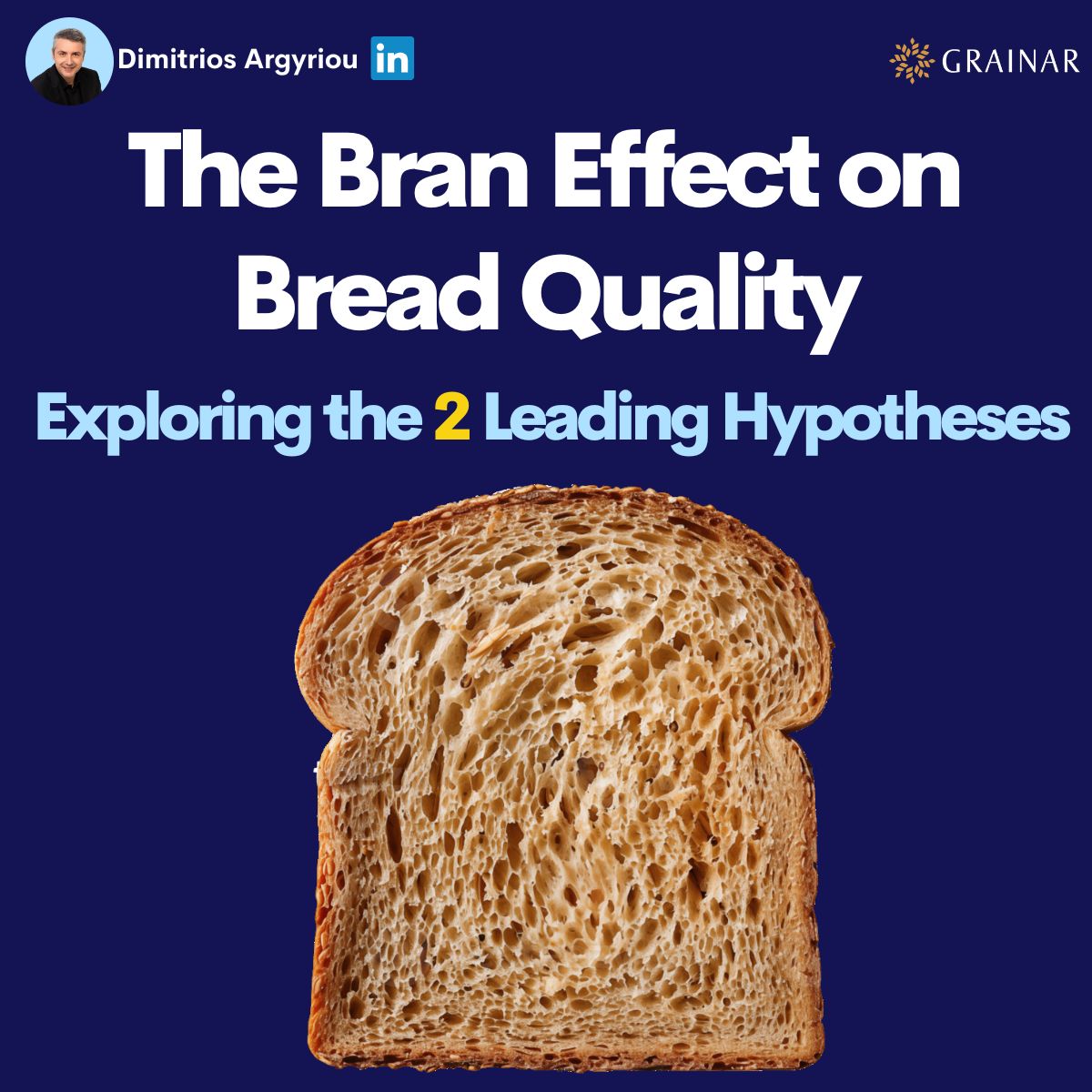تأثير النخالة Wheat Bran على خصائص العجين والخبز 🍞
مرسل: الاثنين نوفمبر 04, 2024 9:44 pm

Consumers regard ,texture, volume and appearance as sensory barriers to whole-wheat bread consumption 🌾👀 There are 2 schools of thought regarding the basic mechanism by which #bran affects #dough and bread properties 🍞🔍. The first 1️⃣ implies competitive water binding by bran 💧🌾 as the major factor affecting the loaf volume and internal crumb structure of whole-wheat bread 🍞. The second 2️⃣ hypothesis contends that bran affects loaf volume and internal crumb structure by physically disrupting the gas cells and the gluten network 🫧🍞. 1. Competitive Water Binding 💧 Bran's high water-absorbing capacity draws moisture away from gluten and starch, two critical components responsible for creating a stable and elastic dough matrix 🌾💧. When bran absorbs significant water, gluten becomes partially dehydrated, limiting its elasticity and extensibility 📉. This ultimately results in a denser crumb structure and reduced loaf volume, leading to a heavier and less airy texture 🥖. 2. Physical Disruption 🧱 Bran particles act as physical disruptors in the dough matrix, creating weak points in the gluten network that can reduce the dough's ability to retain gas during proofing and baking 🌬️🥖. This disruption in the gluten network affects gas cell stability, leading to gas escape and ultimately resulting in a denser and more compact bread crumb 🍞. 🔹 Interaction of Mechanisms 🔄 Competitive water binding and physical disruption likely interact in a way that compounds the effect on bread quality 🌾⚖️. For instance, when bran absorbs water, gluten partially dehydrates, reducing its viscoelasticity and compromising its ability to form a cohesive network 🥖. This "chain reaction" weakens the gluten network's gas-trapping ability, leading to a partial collapse and more compact crumb structure 🍞. These combined mechanisms are significant contributors to the dense, compact characteristics often seen in whole-grain breads 🌾🍞. Recognizing this interplay is essential for formulating solutions that address both moisture distribution and structural stability in dough 🔍🔧. 🔹Optimization Techniques 💡 1. Pre-hydration of Bran: By pre-soaking bran before adding it to the dough, bakers can reduce its water absorption during mixing, helping to preserve the dough's hydration balance 💧🌾. This technique improves gluten hydration, allowing it to develop elasticity and strength more effectively 💪. 2. Enzyme Treatments: Specific enzymes, such as xylanases and cellulases 🧬, can break down components in bran that interfere with gluten development, thus enhancing gluten structure and supporting better gas retention in the dough A post dedicated to enzyme treatment will follow soon—stay tuned📡 Thanks for reading✨📚
GRAINAR
#breadmaking #wholewheat #gluten #rheology #enzymes #Grainar
https://www.linkedin.com/mwlite/feed/posts/dimitrios-argyriou-1a38251b6_consumers-bran-dough-activity-7259070292096925696-CntS?utm_source=share&utm_medium=member_android#:~:text=%23Consumers%20regard%20%2Ctexture,enzymes%20%23Grainar
يعتبر المستهلكون أن القوام والحجم والمظهر حواجز حسية أمام استهلاك الخبز المصنوع من القمح الكامل 🌾👀. هناك مدرستان فكريتان بشأن الآلية الأساسية التي يؤثر بها النخالة على خصائص العجين والخبز 🍞🔍. تفترض المدرسة الأولى 1️⃣ أن امتصاص الماء التنافسي بواسطة النخالة 💧🌾 هو العامل الرئيسي الذي يؤثر على حجم الرغيف وبنية الفتات الداخلية للخبز المصنوع من القمح الكامل 🍞. بينما تقول الفرضية الثانية 2️⃣ إن النخالة تؤثر على حجم الرغيف وبنية الفتات الداخلية من خلال تعطيل الخلايا الغازية وشبكة الجلوتين بشكل مادي 🫧🍞.
1. امتصاص الماء التنافسي 💧 تتمتع النخالة بقدرة عالية على امتصاص الماء، مما يسحب الرطوبة بعيدًا عن الجلوتين والنشا، وهما مكونان أساسيان مسؤولان عن تشكيل شبكة عجين مستقرة ومرنة 🌾💧. عندما تمتص النخالة كمية كبيرة من الماء، يتعرض الجلوتين للجفاف الجزئي، مما يحد من مرونته وقابليته للتمدد 📉. يؤدي ذلك في النهاية إلى بنية فتات أكثر كثافة وحجم رغيف منخفض، مما يعطي الخبز قوامًا أثقل وأقل تهوية 🥖.
2. التعطيل المادي 🧱 تعمل جسيمات النخالة كعوامل تعطيل مادية في شبكة العجين، مما يخلق نقاط ضعف في شبكة الجلوتين التي يمكن أن تقلل من قدرة العجين على الاحتفاظ بالغاز أثناء التخمير والخبز 🌬️🥖. يؤثر هذا التعطيل في استقرار الخلايا الغازية، مما يؤدي إلى هروب الغاز وينتج في النهاية فتات خبز أكثر كثافة وتماسكًا 🍞.
🔹 تفاعل الآليات 🔄 من المحتمل أن يتفاعل امتصاص الماء التنافسي والتعطيل المادي بطريقة تزيد من تأثيرهما على جودة الخبز 🌾⚖️. على سبيل المثال، عندما تمتص النخالة الماء، يجف الجلوتين جزئيًا، مما يقلل من لزوجته وقدرته على تشكيل شبكة متماسكة 🥖. يؤدي هذا "التفاعل المتسلسل" إلى إضعاف قدرة شبكة الجلوتين على احتجاز الغاز، مما يؤدي إلى انهيار جزئي وبنية فتات أكثر كثافة 🍞. تساهم هذه الآليات المشتركة بشكل كبير في الخصائص الكثيفة والمتماسكة التي تُرى غالبًا في الخبز المصنوع من الحبوب الكاملة 🌾🍞. إن إدراك هذا التفاعل ضروري لتطوير حلول تعالج توزيع الرطوبة واستقرار هيكل العجين 🔍🔧.
🔹 تقنيات التحسين 💡
1. ترطيب النخالة مسبقًا: من خلال نقع النخالة قبل إضافتها إلى العجين، يمكن للخبازين تقليل امتصاصها للماء أثناء الخلط، مما يساعد في الحفاظ على توازن ترطيب العجين 💧🌾. تعمل هذه التقنية على تحسين ترطيب الجلوتين، مما يسمح له بتطوير المرونة والقوة بشكل أكثر فعالية 💪.
2. العلاجات الإنزيمية: يمكن لبعض الإنزيمات، مثل الزيلاناز والسليولاز 🧬، أن تكسر مكونات في النخالة تتداخل مع تطوير الجلوتين، مما يعزز بنية الجلوتين ويدعم احتباس الغاز بشكل أفضل في العجين. سيتبع قريبًا منشور مخصص للعلاج الإنزيمي—تابعونا 📡